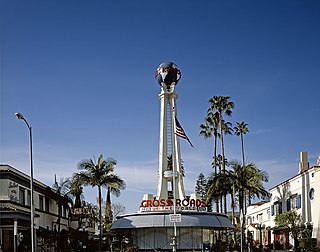
Crossroads of the World is an open-air mall on Sunset Boulevard and Las Palmas in Los Angeles. The mall features a central building designed to resemble an ocean liner surrounded by a small village of cottage-style bungalows. It was designed by Robert V. Derrah, built in 1936, and has been called America's first outdoor shopping mall.

Whitley Heights is a residential neighborhood and historic preservation overlay zone in the Hollywood Hills neighborhood of Central Los Angeles, California. Known as a residential area for actors and other people in the motion-picture industry, it is divided between a hillside single-family district and an apartment area. It is notable for an attempt by its homeowners' group and the city to close off public streets to outside traffic, an effort that was ruled illegal by the courts.

Wilshire Center is a neighborhood in the Wilshire region of Los Angeles, California.

The Hollywood Knickerbocker Apartments, formerly the Hollywood Knickerbocker Hotel, is a historic former hotel, now retirement home, located at 1714 Ivar Avenue in Hollywood, California.

The Hillview, also known as Hillview Apartments, Historic Hillview Hollywood, The Hudson Apartments, and The Harlan Residences, is a historic building located at 6533 Hollywood Boulevard, Hollywood, California, on the corner of Hollywood Blvd and Hudson Ave. Considered Hollywood's first artist's high-rise, it was a hotspot during the silent era.

Village Green, originally named Baldwin Hills Village, is a neighborhood at the foot of Baldwin Hills, within the city of Los Angeles, California. Village Green consists of a large condominium complex that is both a Los Angeles Historic-Cultural Monument and a National Historic Landmark. Designed in the late 1930s and completed by 1942, it is one of the oldest planned communities of its type in the nation. Village Green was named by The American Institute of Architects as one of the 100 most important architectural achievements in U.S. history.

Jardinette Apartments, now known as Marathon Apartments, is a four-story apartment building in Hollywood, Los Angeles, California, designed by modernist Richard Neutra. It was Neutra's first commission in the United States. In his book Key Buildings of the Twentieth Century, Richard Weston called the Jardinette Apartments "one of the first Modernist buildings in America." It has also been called "America's first multi-family, International-style building."
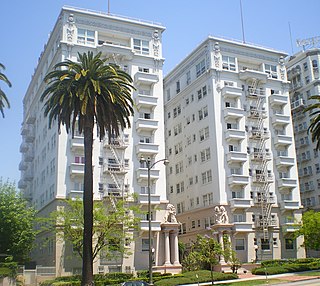
The Bryson Apartment Hotel is a historic 110,000-square-foot (10,000 m2), ten-story apartment building on Wilshire Boulevard in the MacArthur Park section of Los Angeles, California. Built in 1913 in the Beaux Arts style, it was one of the most luxurious residential buildings in Los Angeles for many years. The building is also closely associated with the city's film noir history, having been featured in Raymond Chandler's works and the 1990 neo-noir The Grifters. The building's stone lions and large rooftop "Bryson" sign have become Los Angeles landmarks. It was added to the National Register of Historic Places in 1983 and designated a Historic Cultural Monument (#653) by the Los Angeles Cultural Heritage Commission in 1998.
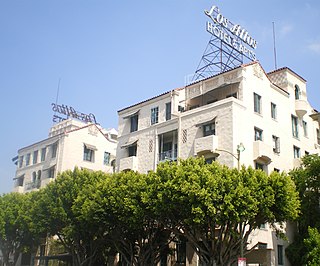
The Los Altos Apartments is a Mission Revival-style apartment building on Wilshire Boulevard in Los Angeles, California.

The Town House is a large former hotel property built in 1929 on Wilshire Boulevard, adjacent to Lafayette Park in the Westlake district of Los Angeles, California. After a long career as a hotel it operates today as low income housing.
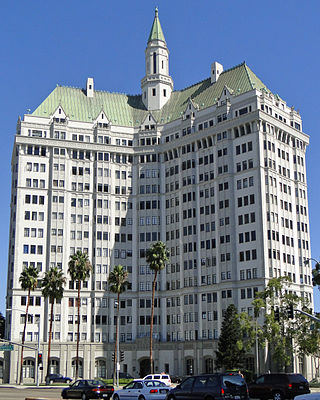
Villa Riviera is a registered historic building on Ocean Boulevard in the Alamitos Beach neighborhood of Long Beach, California, United States. The building was an "own-your-own" apartment building and each unit was sold fully furnished. In those days, Apartment-Hotels were apartment buildings featuring full service hotel amenities. The Villa Riviera provided maid service, valets, doormen, concierge, and managers on duty to cater to the needs of residents. The Villa Riviera was completed, and the owners moved in, by the end of 1928 to enjoying a grand opening party January 1929.

Cooper Arms Apartments is a registered historic building located on Ocean Boulevard in downtown Long Beach, California. The twelve-story Renaissance Revival apartment tower was built in 1923. It was one of the first structures to be designated a Long Beach Historical Landmark when the city launched its historic preservation program in 1980, and it was added to the National Register of Historic Places in 2000. It is currently operated as condominiums.

The Broadway Hollywood Building is a building in Los Angeles' Hollywood district. The building is situated in the Hollywood Walk of Fame monument area on the southwest corner of the intersection referred to as Hollywood and Vine, marking the intersection of Hollywood Boulevard and Vine Street. It was originally built as the B. H. Dyas Building in 1927. The Broadway Hollywood Building is referred to by both its main address of 6300 Hollywood Boulevard and its side address of 1645 Vine Street.

Hollywood Plaza Hotel, also known as Plaza Hotel, was a 200-room hotel located at 1633–37 North Vine Street in Hollywood, California, just south of Hollywood and Vine. A popular venue for film, radio, and theatre stars of the 1930s, 1940s, and 1950s, the building was converted into a retirement home in the 1970s.
Edward B. Rust was an American architect who designed many buildings in Los Angeles, California.

The Hollywood Boulevard Commercial and Entertainment District is a historic district that consists of twelve blocks between the 6200 and 7000 blocks of Hollywood Boulevard in Los Angeles, California. This strip of commercial and retail businesses, which includes more than 100 buildings, is recognized for its significance with the entertainment industry, particularly Hollywood and its golden age, and it also features the predominant architecture styles of the 1920s and 1930s.

The Hollywood Professional Building, also known as SEVENTY46, is a historic eight-story building at 7046 W. Hollywood Blvd. in Hollywood, California. The Los Angeles Department of City Planning describe the building as exhibiting "character defining features of Neo-Gothic style architecture" and the United States Department of the Interior describe it as "an excellent example of Neo-Gothic commercial design."
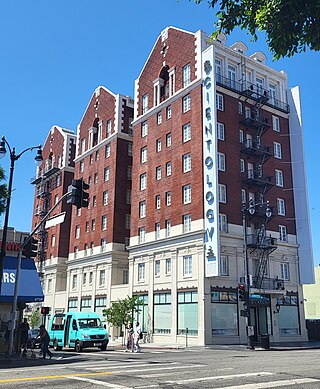
The Christie Hotel is a historic eight-story building at 6724 W. Hollywood Blvd. in Hollywood, California. Considered Hollywood's first skyscraper and also its first luxury hotel, the building features Georgian Revival architecture and has been described as "an excellent example of its style" by the United States Department of the Interior.
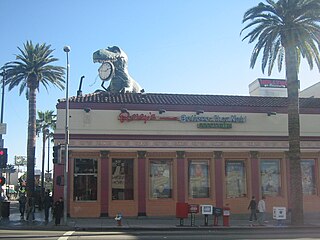
Hollywood's Bank of America Building, also known as the C.E. Toberman and Co. Building, is a historic building located at 6780 W. Hollywood Boulevard and 1668 Highland Avenue in Hollywood, California. Named after its former tenant, the building currently houses a Ripley's Believe It or Not! Odditorium.

The Johnny Grant Building, also known as Arthur Murray, is a historic two-story building located at 7024 W. Hollywood Boulevard in Hollywood, California. It was formerly home to a Arthur Murray Dance Studio and is currently part of the Hollywood Roosevelt Hotel complex.



















